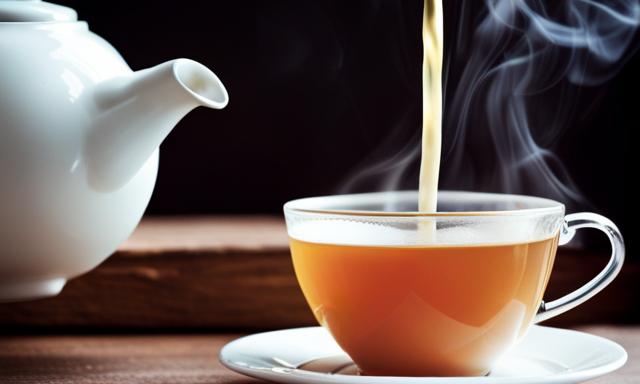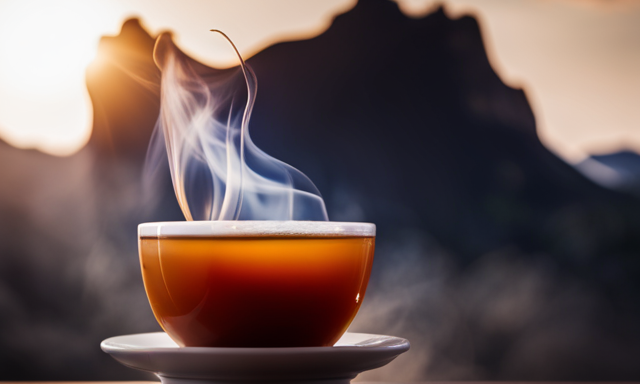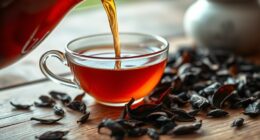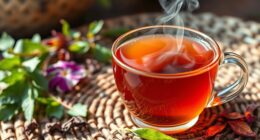Tea, a comforting and invigorating beverage, has been a beloved part of cultures around the world for centuries. As a tea enthusiast, I have always been fascinated by the diverse range of flavors and aromas that different tea types offer. Among the vast array of teas, two popular varieties stand out: oolong and black tea.
Exploring the difference between these two teas is like comparing the smoothness of silk to the richness of velvet.
In this article, we will delve into the distinct characteristics that set oolong and black tea apart. From the production process to the flavor profiles, caffeine content, and even the health benefits, we will leave no leaf unturned.
Additionally, we will explore the cultural significance of these teas and provide recommendations for pairing them with delectable food choices. By the end, you will be equipped with the knowledge to choose the perfect tea to suit your taste preferences.
So, let’s embark on this tea journey together and discover the nuances that make oolong and black tea truly unique.
Key Takeaways
- Oolong tea is brewed at a lower temperature and for a shorter time compared to black tea.
- Oolong tea offers a diverse range of flavors, from floral to toasty, while black tea is bold and robust.
- Oolong tea is culturally significant in Chinese traditions, symbolizing hospitality and respect, while black tea is a staple of afternoon tea in Western culture.
- Oolong tea pairs well with light and fresh dishes, seafood, cheese, and chocolate, while black tea complements heartier foods, breakfast items, and creamy desserts.
Brief Introduction to Tea Types
As you delve into the world of tea, you’ll quickly discover that there are various types available, each with its own unique characteristics and brewing methods.
Tea, renowned for its health benefits, can be classified into different categories such as green, black, white, oolong, and herbal. Each type undergoes a different level of oxidation, which affects its taste and aroma.
When it comes to brewing techniques, it’s important to consider the water temperature and steeping time to achieve the desired flavor profile.
Now, let’s delve into the production process of oolong and black tea.
The Production Process of Oolong and Black Tea
To fully appreciate the intricate flavors of these two distinct varieties, imagine yourself standing in the midst of a tea garden, witnessing the meticulous processes involved in crafting the delicate oolong and robust black brews.
The production techniques used for oolong and black tea differ in terms of oxidation levels. Oolong tea undergoes partial oxidation, where the leaves are gently rolled and bruised to allow enzymatic reactions to occur. This process creates a wide range of flavors, from floral and fruity to toasty and nutty.
On the other hand, black tea undergoes full oxidation, resulting in a stronger and bolder flavor profile. The leaves are fully rolled and exposed to air, allowing the enzymes to fully oxidize and develop rich, malty, and sometimes even smoky notes.
Transitioning into the next section about the flavor profiles of oolong and black tea, we can now explore the distinct characteristics that arise from these production techniques.
Flavor Profiles of Oolong and Black Tea
When it comes to the flavor profiles of Oolong and Black Tea, there are distinct differences that make each tea unique.
Oolong tea is known for its complex and delicate taste, with notes of floral, fruity, and sometimes even honey-like flavors.
On the other hand, black tea is bolder and stronger, with a robust and rich flavor that often has hints of malt, caramel, and even chocolate.
Exploring these flavor notes can provide a delightful experience for tea enthusiasts, allowing them to appreciate the diverse range of flavors that these teas have to offer.
Oolong Tea Flavor Notes
The enticing aroma of oolong tea fills the air, with its smooth and slightly floral flavor dancing on the taste buds. Oolong tea, also known as ‘semi-fermented’ tea, offers a unique taste experience that sets it apart from other teas. Here are four flavor notes that make oolong tea a delight to savor:
-
Creamy: Oolong tea has a velvety texture and a creamy note that adds richness to every sip.
-
Fruity: Depending on the variety, oolong tea can have fruity undertones like peach, apple, or citrus, adding a refreshing twist to its flavor.
-
Earthy: Oolong tea carries a subtle earthy taste, reminiscent of fresh leaves and the natural environment where it is grown.
-
Sweet: Oolong tea often has a naturally sweet taste that lingers on the palate, making it a delightful treat for those with a sweet tooth.
Now, let’s explore the flavor notes of black tea.
Black Tea Flavor Notes
Black tea flavor notes are bold and robust, enveloping the senses in a rich and invigorating embrace. The aroma of black tea is often described as malty, with hints of caramel and even a touch of smokiness. This distinct flavor is a result of the unique processing method used for black tea. The tea leaves are fully oxidized before they are dried and brewed, giving black tea its deep and complex flavor. This sets it apart from other types of tea like oolong. It’s important to note that the flavor profiles are just one aspect that distinguishes these two teas. Now, let’s move on to explore the caffeine content comparison between oolong and black tea.
Caffeine Content Comparison
Oolong tea packs a moderate punch of caffeine, while black tea delivers a stronger jolt to keep you energized throughout the day. When it comes to caffeine content and health effects, both oolong and black tea have their own unique characteristics.
Caffeine, a natural stimulant found in tea, can provide a temporary energy boost and enhance cognitive function. However, excessive consumption of caffeine can lead to adverse effects such as increased heart rate, anxiety, and sleep disturbances.
Speaking of sleep patterns, it’s important to note that the impact of caffeine differs from person to person. Some individuals may experience difficulty falling asleep or disrupted sleep after consuming caffeine, especially in the evening. In contrast, others may not be affected at all.
Moving on to the next section about the health benefits of oolong and black tea, these teas offer more than just a caffeine fix.
Health Benefits of Oolong and Black Tea
Oolong tea and black tea both offer numerous health benefits.
Oolong tea is known for its ability to aid in weight loss, improve digestion, and promote a healthy heart.
On the other hand, black tea is rich in antioxidants, which can help boost the immune system, reduce the risk of chronic diseases, and improve mental alertness.
Both teas provide a delicious and beneficial way to incorporate healthy habits into your daily routine.
Oolong Tea Health Benefits
Incorporate oolong tea into your daily routine to enjoy its numerous health benefits.
Oolong tea, known for its unique taste and aroma, offers a range of advantages for your well-being. Compared to green tea, oolong tea undergoes a partial oxidation process, giving it a distinct flavor profile.
One of the key benefits of oolong tea is its potential to aid in weight loss. The polyphenols in oolong tea help boost metabolism and fat oxidation, making it a popular choice for those seeking to shed pounds.
Additionally, oolong tea is rich in antioxidants, which can protect against free radicals and promote overall health.
As we transition to discussing the health benefits of black tea, it’s important to note that both oolong and black tea offer unique advantages.
Black Tea Health Benefits
Indulge in the aromatic richness of black tea and unlock a myriad of health benefits that will leave you feeling revitalized and rejuvenated. Black tea, like its counterpart green tea, is derived from the Camellia sinensis plant. However, the difference lies in the oxidation process, where black tea is fully oxidized while green tea is not. This process gives black tea its distinct flavor and darker color.
Black tea is packed with antioxidants, such as theaflavins and thearubigins, which have been shown to reduce the risk of chronic diseases, including heart disease and certain types of cancer. Additionally, it contains caffeine, which provides a natural energy boost without the jitters associated with coffee.
Let’s compare the benefits of black tea to green tea in a visual representation:
| Black tea benefits | Green tea benefits |
|---|---|
| Rich in antioxidants | High in antioxidants |
| Boosts heart health | Supports brain function |
| Enhances oral health | Aids in weight loss |
| Provides energy | Calms the mind |
Now that we’ve explored the health benefits of black tea, let’s delve into the brewing techniques for oolong and black tea.
Brewing Techniques for Oolong and Black Tea
When it comes to brewing techniques for oolong and black tea, finding the right steeping time is crucial for a perfect cup. Here are some tips to help you achieve the best results:
-
Temperature: Oolong tea is best brewed at around 190-200°F (88-93°C), while black tea requires boiling water at 212°F (100°C) to fully extract its flavors.
-
Steeping Time: For oolong tea, steeping for 3-5 minutes will bring out its delicate flavors. On the other hand, black tea requires a longer steeping time of 4-6 minutes to develop its bold and robust taste.
-
Experimentation: Don’t be afraid to adjust the steeping time to suit your personal preference. Some people prefer a stronger brew, while others enjoy a milder taste.
-
Enjoy the Aroma: Before taking your first sip, take a moment to inhale the enticing aroma of the tea. It adds to the overall sensory experience.
Now that you know the brewing techniques for oolong and black tea, let’s explore the popular varieties of each.
Popular Varieties of Oolong and Black Tea
To truly appreciate the diverse flavors of oolong and black tea, it’s important to explore the popular varieties available. Oolong tea offers a delicate and complex taste that can range from floral and fruity to toasty and nutty. Some popular oolong flavors include Tie Guan Yin, which is known for its orchid-like aroma, and Da Hong Pao, which offers a bold and smoky flavor.
On the other hand, black tea is known for its robust and full-bodied taste, often accompanied by malty and caramel notes. There are several popular black tea flavors to choose from. For example, Earl Grey is a classic choice with its distinctive bergamot flavor. Another popular option is English Breakfast, a blend that has a rich and robust taste.
Understanding the different flavors of oolong and black tea can enhance your brewing techniques and allow you to fully enjoy their unique characteristics.
Moving forward, let’s explore the cultural significance of oolong and black tea.
Cultural Significance of Oolong and Black Tea
Oolong tea holds a significant place in Chinese culture. It is often used in traditional tea ceremonies and is considered a symbol of hospitality and respect. Its delicate flavor and aroma are highly valued. Oolong tea is often enjoyed during important social gatherings and celebrations.
On the other hand, black tea has a long-standing history in Western culture, particularly in countries like England. It is a staple of afternoon tea and is known for its bold and robust flavor. Black tea is often enjoyed with milk and sugar.
Oolong Tea in Chinese Culture
Discover the rich cultural significance of oolong tea in Chinese traditions, transporting yourself to a world where every sip tells a story.
Oolong tea has a long and fascinating history in China, dating back centuries. It is believed to have originated in the Fujian province during the Ming Dynasty.
Oolong tea ceremonies are an integral part of Chinese culture, where the preparation and serving of this tea is considered an art form. These ceremonies symbolize respect, harmony, and tranquility.
Oolong tea is often enjoyed during special occasions and gatherings, and it is believed to have numerous health benefits.
From its delicate floral notes to its complex flavors, oolong tea holds a special place in the hearts of the Chinese people.
Now, let’s delve into the world of black tea in western culture, where its robust taste and bold aroma have captivated tea lovers for centuries.
Black Tea in Western Culture
Immerse yourself in the captivating world of black tea. Its bold flavor and rich aroma have been embraced by tea enthusiasts throughout Western culture for centuries.
Black tea, like oolong tea, is made from the Camellia sinensis plant. However, it undergoes a different level of oxidation, resulting in a distinct taste and color.
In addition to its robust flavor, black tea offers numerous health benefits. Packed with antioxidants, it can help boost the immune system and promote heart health.
Furthermore, black tea has a long and fascinating history. Originating in China, it was introduced to the West in the 17th century and quickly became a popular beverage.
As we transition to the next section about pairing oolong and black tea with food, let’s explore the perfect harmony of flavors that awaits.
Pairing Oolong and Black Tea with Food
When it comes to pairing oolong tea with food, there are a few key points to consider. Oolong tea is known for its delicate and floral flavors, making it a great match for light and fresh dishes like salads or seafood.
On the other hand, black tea has a stronger and bolder flavor profile, making it a perfect accompaniment to heartier and richer foods like grilled meats or chocolate desserts.
So, whether you’re looking for a light and refreshing option or a more robust and satisfying pairing, both oolong and black tea have you covered.
Oolong Tea Food Pairings
Try pairing oolong tea with your favorite seafood dishes for a delightful culinary experience. Oolong tea’s unique flavor profile, which is both floral and toasty, complements the delicate flavors of seafood perfectly. The light and refreshing nature of oolong tea helps cleanse the palate and enhance the taste of seafood, making it a fantastic pairing option.
To further elevate your oolong tea experience, consider pairing it with cheese or chocolate. The complex flavors of oolong tea can beautifully complement the creamy and rich flavors of cheese, creating a harmonious balance. Similarly, the slightly sweet and roasted notes of oolong tea can enhance the richness and depth of chocolate, resulting in a decadent combination.
To help you make the most of these pairings, here is a table showcasing some popular oolong tea food pairings:
| Oolong Tea Pairing | Food Pairing |
|---|---|
| Seafood | Grilled fish or shrimp |
| Cheese | Brie or Gouda |
| Chocolate | Dark chocolate truffles |
| Fruits | Fresh berries or peaches |
| Nuts | Almonds or cashews |
Now that we’ve explored oolong tea food pairings, let’s delve into the exciting world of black tea pairings.
Black Tea Food Pairings
Enhance your culinary experience with black tea by pairing it with a variety of delectable dishes that will tantalize your taste buds.
Black tea, known for its robust flavor and rich aroma, is a versatile beverage that complements both sweet and savory flavors. Its deep, malty notes make it a perfect match for hearty breakfast foods like scones, muffins, and pancakes.
Additionally, the tannins in black tea help cleanse the palate, making it an excellent accompaniment to rich and creamy desserts such as chocolate cake or crème brûlée.
Not only does black tea elevate your dining experience, but it also offers numerous health benefits. Packed with antioxidants, black tea can boost your immune system and promote heart health. It is also known to improve digestion and reduce inflammation.
As for brewing techniques, black tea is typically steeped for 3-5 minutes in boiling water. Adjust the steeping time and water temperature based on your personal preference for a stronger or milder flavor.
Now that you know about the food pairings and health benefits of black tea, let’s dive into choosing the right tea for your taste preferences.
Choosing the Right Tea for Your Taste Preferences
If you want a tea that perfectly matches your taste buds, oolong and black tea offer distinct flavor profiles to satisfy your cravings. Oolong tea is known for its complex and delicate taste, with a range of flavors that can be floral, fruity, or even nutty. Black tea, on the other hand, is bold and robust, with a rich and malty flavor that is often described as full-bodied. When it comes to brewing methods, both oolong and black tea can be steeped using hot water, but oolong tea requires a shorter steeping time compared to black tea. Tea tasting techniques also differ, as oolong tea is often sipped slowly to savor its intricate flavors, while black tea is commonly enjoyed with milk or sugar.
| Tea Type | Flavor Profile | Brewing Time |
|---|---|---|
| Oolong | Complex, delicate | Short |
| Black | Bold, robust | Longer |
In conclusion, choosing the right tea for your taste preferences depends on whether you prefer a tea with a complex and delicate flavor (oolong) or a bold and robust flavor (black). Consider the brewing methods and tea tasting techniques to further enhance your tea-drinking experience.
Frequently Asked Questions
What is the difference in color between oolong and black tea?
When it comes to appearance, oolong and black tea are like night and day. Oolong tea boasts beautiful golden hues, while black tea is as dark as a moonless night. The color variations between the two are striking.
Are oolong and black tea made from the same type of tea plant?
No, oolong and black tea are not made from the same type of tea plant. They come from different tea plant varieties, resulting in distinct flavors, aromas, and processing methods. Oolong vs black tea, different tea plants.
Can oolong and black tea be combined to create a unique blend?
Yes, oolong and black tea can be combined to create a unique blend. By using unique blending techniques, we can create a harmonious marriage of their distinct flavor profiles, resulting in a delicious and complex cup of tea.
How do the processing methods of oolong and black tea affect their flavor?
The flavor profiles of oolong and black tea are influenced by their different oxidation levels. Oolong tea has a more nuanced and floral taste, while black tea is richer and bolder.
Are there any special storage requirements for oolong and black tea to maintain their quality?
To maintain the quality of oolong and black tea, there are special storage requirements. Properly storing them in airtight containers away from light, heat, and moisture helps preserve their flavor, aroma, and overall quality over time.
Conclusion
After exploring the differences between oolong and black tea, it is clear that these two types of tea have distinct characteristics and flavors.
The production process, flavor profiles, and caffeine content all contribute to their unique qualities.
Additionally, both teas offer various health benefits and have a rich cultural significance.
Whether you prefer the floral and fruity notes of oolong or the robust and bold taste of black tea, choosing the right tea for your taste preferences is a delightful journey of discovery.
So, next time you brew a cup of tea, savor the moment and let the tea captivate your senses.










